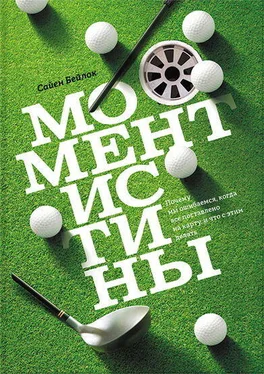112.Klein K., Boals A. Expressive writing can increase working memory capacity // Journal of Experimental Psychology: General, 2001. Vol. 130. Pp. 520–533.
113.Lieberman M. D. et al. Putting feelings into words: affect labeling disrupts amygdala activity in response to affective stimuli // Psychological Science, 2007. Vol. 18. Pp. 421–428.
114.Lutz A., Slagter H. A., Dunne J. D., Davidson R. J. Attention regulation and monitoring in meditation // Trends in Cognitive Science, 2008. Vol. 12. Pp. 163–169. См. также: What the Beatles gave science // Newsweek, 2007. November 19.
115.Pagnoni G. et al. ‘Thinking about not-thinking’: Neural correlates of conceptual processing during Zen meditation // PLoS ONE, 2008. P. e3083.
116.Slagter H. A. et al. Mental training affects distribution of limited brain resources // PLoS Biol. 2007. Vol. 5. P. e138.
117.Beilock S. L., Todd S., Lyons I., Lleras A. Meditating the pressure away (в работе).
118.Wall Street bosses, Tiger Woods meditate to focus, stay calm // http://www.bloomberg.com/apps/news?pid=20601088&sid=aR2aP.X_Bflw&refer=muse#.
119.Just say om // Time, 2003. August 4 // http://www.time.com/time/magazine/article/0,9171,1005349,00.html.
120.Shih M., Pittinsky T. L., Ambady N. Stereotype susceptibility: Identity salience and shifts in quantitative performance // Psychological Science, 1999. Vol. 10. Pp. 80–83.
121.Gresky D. M., Eyck L. L. T., Lord C. G., McIntyre R. B. Effects of salient multiple identities on women’s performance under mathematical stereotypes // Sex Roles, 2005. Vol. 53. Pp. 703–716.
122.Дополнительно см.: http://reducingstereotypethreat.org/reduce.html#deemphasizing. См. также: Danaher K., Crandall C. S. Stereotype threat in applied settings re-examined // Journal of Applied Social Psychology, 2008. Vol. 38. Pp. 1639–1655.
123.Marx D. M., Ko S. J., Friedman R. A. The ‘Obama Effect’: How a salient role model reduces race-based performance differences // Journal of Experimental Social Psychology, 2009. Vol. 45. Pp. 953–956. Обратите внимание, что отсутствие существенных различий в результатах между белыми и темнокожими участниками эксперимента после речи Обамы на Конгрессе Демократической партии было зафиксировано только у тех, кто действительно слушал его речь. См. также: Aronson J., Jannone S., McGlone M., Johnson-Campbell T. The Obama effect: An experimental test // Journal of Experimental Social Psychology, 2009. Vol. 45. Pp. 957–960 (в этой статье речь об ограничениях работы Маркса и коллег).
124.Dasgupta N., Asgari S. Seeing is believing: Exposure to counter stereotypic women leaders and its effect on the malleability of automatic gender stereotyping // Journal of Experimental Social Psychology, 2004. Vol. 40. Pp. 642–658. Обратите внимание, что мнения женщин изучались в ходе Implicit Association Test (IAT), который рассчитан на определение того, как люди подсознательно оценивают качества женщин как лидеров по сравнению с ролью ведомых.
125.Carrell S. E., Page M. E., West J. E. Sex and science: How professor gender perpetuates the gender gap // National Bureau of Economic Research Working Paper, 14959, May 2009 // http://www.nber.org/papers/w14959.
126.Johns M., Schmader T., Martens A. Knowing is half the battle: Teaching stereotype threat as a means of improving women’s math performance // Psychological Science, 2005. Vol. 16. Pp. 175–179. Этот эксперимент подразумевает общее информирование женщин о стереотипах по поводу их способностей к математике, а также подчеркивание того, что данные стереотипы именно к ним не относятся.
127.National Science Foundation, Science and Engineering Indicators, 2006.
128.Women in science: The battle moves to the trenches // New York Times, 2006. December 19.
129.Cultivating Female Scientists, Spring 2008 // http://www.winchesterthurston.org.
130.The WISE program: http://www.gfs.org/academics/the-wise-program/index.aspx#1. Обратите внимание, что в данной программе участвуют как преподаватели-мужчины, так и преподаватели-женщины.
131.American Society for Cell Biology, Newsletter, 2004. Vol. 27. No. 7.
Глава 7
132.См.: Jackson R., Beilock S. L. Attention and performance // D. Farrow, J. Baker, C. MacMahon, eds. Developing Elite Sports Performers: Lessons from Theory and Practice. New York: Routledge, 2008. Pp. 104–118.
133.Дополнительно см.: Beilock S. L., Gray R. Why do athletes ‘choke’ under pressure? // G. Tenenbaum, R. C. Eklund, eds. Handbook of Sport Psychology, 3rd ed. Hoboken, N.J.: Wiley, 2007. Pp. 425–444.
134.Calvo-Merino B. et al. Action observation and acquired motor skills: An fmri study with expert dancers // Cerebral Cortex, 2005. Vol. 15. Pp. 1243–1249. См также: Calvo-Merino B. et al. Seeing or doing? Influence of visual and motor familiarity on action observation // Current Biology, 2006. Vol. 16. Pp. 1905–1910.
135.Calvo-Merino B., Glaser D. E., Grezes J. et al. Action observation and acquired motor skills: An FMRI study with expert dancers // Cerebral Cortex, 2005. Vol. 15. Pp. 1243–1249. Приводится с разрешения.
136.Yarrow K., Brown P., Krakauer J. W. Inside the brain of an elite athlete: The neural processes that support high achievement in sports // Nature Reviews Neuroscience, 2009. Vol. 10. Pp. 585–596. Зеркальные нейроны, изначально обнаруженные у макак, работают как во время выполнения человеком определенных задач, так и во время наблюдения за такими же действиями других лиц.
137.Baumeister R. E. Choking under pressure: Self-consciousness and paradoxical effects of incentives on skillful performance // Journal of Personality and Social Psychology, 1984. Vol. 46. Pp. 610–620. Обсуждение см.: Schlenker B. R. et al. Championship pressures: Choking or triumphing in one’s own territory? // Journal of Personality and Social Psychology, 1995. Vol. 68. Pp. 632–641; Baumeister R. E. Disputing the effects of championship pressures and home audiences // Journal of Personality and Social Psychology, 1995. Vol. 68. Pp. 644–648; Schlenker B. R., Phillips S. T., Boneicki K. A., Schlenker D. R. Where is the home choke? // Journal of Personality and Social Psychology, 1995. Vol. 68. Pp. 649–652.
138.Butler J. L., Baumeister R. F. The trouble with friendly faces: Skilled performance with a supportive audience // Journal of Personality and Social Psychology, 1998. Vol. 75. Pp. 1213–1230.
139.Jackson R., Beilock S. L. Attention and performance // D. Farrow, J. Baker, and C. MacMahon, eds. Developing Elite Sports Performers: Lessons from Theory and Practice. New York: Routledge, 2008. Pp. 104–118.
Читать дальше
Конец ознакомительного отрывка
Купить книгу











